
This is a student assignment on Corporate Governance from Fall 2001. It is begin presented here simply as an example of the kind of analysis that you should be looking at. Note that this is not a recommended solution -- not everything in here is "correct." In particular, note my comments.
10 out of 10.
Overall, the information obtained on the company, as well as the analysis
is very good. Note my comments in
red, throughout. Highlighted in
green are parts from your text in order to point out the parts to which I am
responding in my comments.
1.
The Company.
Staples, Inc. and subsidiaries pioneered the office products
superstore concept and is a leading office products distributor, with a total of
1,307 retail stores located in the United States, Canada, the United Kingdom,
Germany, the Netherlands and Portugal as of February 3, 2001. In addition,
Staples has catalog, electronic commerce and contract stationer businesses.
The Standard Industrial Classification for Staples Inc. is Retail
Miscellaneous Shopping Goods Stores.
Staples has four reportable segments:
North American Retail, Contract and Commercial, Staples.com, and European
Operations. The Staples North
American Retail segment consists of the US and Canadian operating units that
operate office supply stores. The
Contract and Commercial segment consists of Staples Direct, Contract, Quill
Corporation and Staples Communications, which sell office products, supplies and
services directly to businesses throughout the US and Canada.
The Staples.com segment includes the operations of Staples e-commerce
businesses. The European Operations
segment consists of six operating units that operate office supply stores in the
United Kingdom, Germany, the Netherlands and Portugal and sell office products
and supplies directly to businesses throughout the United Kingdom and Germany.
What is the source for this information?
2.
Officers
According
to the By-Laws of Staples Inc., the officers of the corporation shall consist of
a president, a treasurer and a secretary and such other officers, including
without limitation a chairman of the board of directors and one or more vice
presidents, assistant treasurers and assistant secretaries, as the board of
directors may from time to time determine.
Exhibit A shows the individuals at the top of the companys governance. The top two officers at the company are Thomas G. Stemberg
(Chairman & CEO) and Ronald L. Sargent (President and Chief Operating
Officer). Both officers receive a
substantial amount in restricted stock awards (to ensure that they do not sell
or transfer the stock after receiving it) besides the salary.
What is the source for this information?

According to the By-Laws, the officers are not required to own stock of
the company. Exhibit C shows that
all executives and directors combined own less than 4% of the companys stock,
a relatively little amount. Since
they are not required to own stock, potentially this can create a conflict with
the shareholders because the interests of the management are not aligned with
their interests. On
the other hand, by choosing not to hold a significant amount of shares, the
companys incumbent management yields a great deal of control to large
shareholders and institutional investors. I
dont think this is true. Most of
the control of management comes from their ability to take day-to-day decisions
without much oversight; this is independent of stock ownership.
In order for management to better represent the shareholders and maintain
the high risk high reward philosophy, the Boards Compensation
Committee has adopted a PARS plan (Performance Accelerated Restricted Stock
Awards) for certain key executives. Under
the plan, shares of Staples RD Stock are granted to executives in consideration
for services. First, this provides
an incentive for the executives to provide outstanding services in pursuit of
financial rewards. Second, by
rewarding them with stock, the Board ensures that the interests of management
coincide with the interest of shareholders.
The shares are restricted the executives are not free to sell
or transfer them until they vest in 2005, which provides a guarantee that
the management will not easily dispose of common interests shared with the
other shareholders. Therefore, even
though officers are not required to be shareholders, they still become
shareholders.
Very
good analysis.
The
purpose of the stock options that represent the amount of $600,000 for Stemberg
and Sargent, and are substantial for other key executives as well, is to provide
an incentive for the management to prioritize the stockholder value maximization
goal. The companys Proxy clearly
states:

Managerial Performance:
For the 26 weeks ended 8/4/01, sales rose 5% to $4.98B. Net income fell 8% to $79.9M. Results reflect higher customer traffic in all channels, offset by a lower gross margin, & the absence of store closure credit. (E-trade)
Explain
how this is related to corporate governance.
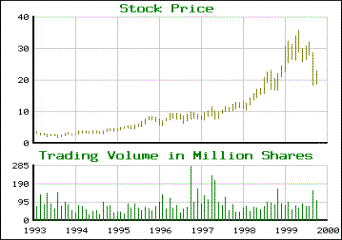
In general, the company takes pride in its corporate governance system when it comes to responsiveness to shareholders interests and needs. The company is followed by 14 analysts (BRIDGE) (If your purpose is to indicate the source of the information, use a footnote and give the name in full, such as Bridge Information Systems), which carries great implications for the management. The number of analysts, which is relatively high for Staples compared to other publicly traded companies, implies that the management must prioritize shareholders interests by increasing the stock value by enhancing growth and earnings. A consensus among many analysts that the forecast for earnings is not bright, or that the stock is overvalued, will cause a plunge in stock price and may lead to a retaliatory actions from stockholders, who will demand explanation from the management. The management in this case would not be able to claim that so many analysts are wrong and will have to take responsibility and may face a prospect of being replaced. Therefore, it is in the best interests of the management to try to have good forecasts from many analysts who follow the company. Currently the company is doing a great job the Wall Street consensus is buy. Good.
3.
The
Board of Directors
According to the corporate By-Laws, the Board of Directors cannot consist
of fewer than five members. The
members of the incumbent Board number sixteen; the Exhibit C shows the
individuals and their affiliations. The
size of the board may be problematic in itself: Business
Week, when rating the companies (you
mean companys singular? No,
it looks like you mean companies plural in this case, you should leave
off the definite article in front) Board efficiency, gave higher grades
to companies that had fewer than 15 members serving on the Board because a
number greater than that would restraint the Boards efficiency and
effectiveness. However, most of the
members are relatively young with the average age in the middle 50s (only one
member is 71 years old), suggesting that the directors can take an active role
in their work.
Again,
whats the source?
The Board deserves a low grade
for independence from management because one of the members is CEO, Thomas G.
Stemberg, and the other is President and Chief Operating Officer Ronald L.
Sargent. Having these two highest
ranking corporate officers on the Board means that the board often looks after
the interests of the management, not shareholders.
In addition, Mr. Stemberg also serves on the Executive Committee, which
is authorized to exercise all the powers of the Board in the management and
affairs of Staples (2001 proxy).
Is
this uncommon?
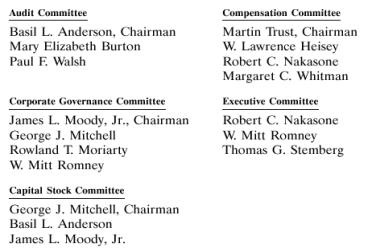
Some other members of the Board also hold management positions in Staples
Inc. For example, James L. Moody is
a Lead Director at Staples and David G. Lubrano is a Business Consultant at
Staples. This means that there is
an insider on the Corporate Governance committee as well.
These two members are not independent in their decisions because they are
insiders and have an incentive to make decisions that benefit the incumbent
management.
In
terms of accountability to stockholders the company deserves a high grade
because under the 1990 Director Stock Option Plan, during the fiscal year ended
February 3, 2001, directors were compensated exclusively through equity rather
than receiving a portion of their compensation in cash (with the exception of
Senator Mitchell who receives a yearly cash compensation of $75,000).
The purpose of the Director Stock Option Plan is to make the directors
think more like shareholders, since they in fact become shareholders by
providing their services. However,
Staples does not make stock ownership one of the eligibility requirements for
the Board and every director owns less than 1% of companys stock, with the
exception of CEO, who owns 1.69%, still a considerably small amount (Exhibit B).
This year only 1 director is up for reelection, but next year 4 directors
will have to be reelected, which makes them more accountable for their actions.
All
of the board members are competent in their job most of them are CEOs and
directors at other companies and have a substantial experience in the area of
corporate decision making. However,
those of them who are still serving active roles in other companies (only two
are retired) potentially can be a source of conflict of interest between their
companies interests and the interests of Staples.
In addition, their duties at other firms prevent them from dedicating
their time and effort to serving the shareholders of Staples.
Therefore, it is doubtful whether they can take a very active role in
running the Board.
4.
Stockholders
Judging by the large amount of disclosed information available about the
company, it can be said that the shareholders have a large degree of control
over the company. When the company
information is readily made public in a timely fashion, this means that the
management acts in the interests of the public, stockholders in particular.
The top Institutional holder of the
company stock is Fidelity Management & Research Corporation with 14.33% of
the outstanding number of shares, followed by Wellington Management Company with
8.78%.
|
Report
Date |
||||||
|
66,538,659
|
13,653,953
|
1,063,953,157
|
14.558%
|
0.215%
|
03/31/2001
|
|
|
40,797,068
|
4,387,900
|
652,345,117
|
8.926%
|
0.437%
|
03/31/2001
|
|
|
18,493,000
|
1,764,000
|
295,703,070
|
4.046%
|
4.736%
|
03/31/2001
|
|
|
17,451,820
|
5,952,655
|
279,054,602
|
3.818%
|
0.134%
|
03/31/2001
|
|
|
9,239,306
|
1,271,169
|
147,736,503
|
2.021%
|
0.047%
|
03/31/2001
|
|
|
7,024,122
|
183,184
|
112,315,711
|
1.537%
|
0.057%
|
06/30/2001
|
|
|
6,887,203
|
-719,192
|
110,126,376
|
1.507%
|
0.126%
|
03/31/2001
|
|
|
6,882,722
|
-1,251,411
|
110,054,725
|
1.506%
|
0.068%
|
03/31/2001
|
|
|
6,800,000
|
-1,350,000
|
108,732,000
|
1.488%
|
0.049%
|
03/31/2001
|
|
|
5,728,200
|
409,600
|
91,593,918
|
1.253%
|
1.386%
|
03/31/2001
|
Source:
E-trade.
Staples
is not a disproportionate share of any of these institutional holders total
assets: they are well diversified.
(What is the relevance of this comment?)
Exhibit D shows the top mutual fund holders of Staples stock,
with Fidelity Magellan Fund leading the list with 4.80%.
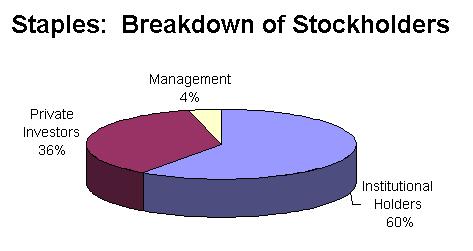
Compared
to other companies in the same industry (how
do you know this? Whats your
source?), relatively large percentage of the outstanding stock is owned
by institutional investors and very small percentage is owned by the management
(Executive Officers and the Board of Directors), putting the control of the
company largely in the hands of shareholders, such as private and institutional
investors. Therefore, it can be
concluded that the average stockholder of Staples is an institutional investor.
Is this good or bad?
5.
Conflicts of Interest (in recent occurrences)
A.
$50 Million Stock Buyback plan.
(Reuters)
Following the events of September 11th, and the following
removal of buyback restrictions by SEC, Staples announced on 9/20/2001 its plan
to buy back $50 Million worth of stock. Staples
said the repurchased stock will be added to the company's treasury shares and
may be used for employee benefit and stock option programs, as well as other
corporate programs. (Source:
Reuters)
Equity repurchases may
provide a way of increasing insider control in companies because they reduce the
number of outstanding shares. The
company and its employees will end up holding larger percentage of the stock,
and consequently, having greater control. On
the other hand, equity repurchasing is traditionally considered to be an action
that benefits both the firm and its stockholders because stockholders benefit
from resulting price appreciation, advantageous tax treatment, and the voluntary
nature of surrendering the shares for cash.
Good.
B.
Staples Inc. Names Basil L. Anderson Vice Chairman.
(Business Wire)
Sep 19, 2001 -- Basil L. Anderson, 56, the former chief financial officer
and treasurer who helped reshape Campbell Soup Co., has joined Staples Inc. as
vice chairman. Mr. Anderson has to
report directly to Ronald L. Sargent, the President of the company. The potential problem is that Mr. Anderson serves on the
Board of Directors since 1997 and is a chairman of the Audit Committee.
His appointment puts one more insider on the Board and aligns the
interests of the Board more closely with the management, as opposed to
shareholders. The independence of
the Board is greatly reduced by this development.
C.
Recapitalization. (Business Wire, 10K, 10Q)
During
1999, Staples stockholders approved a Tracking Stock Proposal which allowed the
issue of new series of common stock, Staples.com Stock, intended to track the
performance of e-commerce business, which operates under the name Staples.com.
Staples' existing common stock was reclassified as Staples Retail and Delivery
common stock ("Staples RD Stock"), intended to track the performance
of Staples Retail and Delivery. On
March 15, 2001, the Board of Directors approved a proposal to seek stockholders'
approval to effect a recapitalization by reclassifying the separate series of
Staples.com Stock and recombine the two outstanding series of Staples' common
stock into a single series representing all of Staples' businesses. At an annual
meeting, the stockholders were asked to consider and approve a proposal to amend
Staples' certificate of incorporation to effect the recapitalization and to
rename the resulting single series of common stock as "Staples Common
Stock." By integrating the catalog operation with Staples.com, Staples
hopes to achieve synergies and efficiencies in how it markets to and services
customers in both operations.
Following
the public announcement of the proposed reclassification, various stockholders
of Staples expressed concerns that the members of the Board of Directors would
benefit from the exchange of their shares of Staples.com.
On March 29th, 2001, the Board met to discuss these
stockholder concerns and reached the consensus that the public must be assured
that in order to preserve the highest level of integrity and good corporate
governance, the Reclassification Ratio is fair to all stockholders and that any
appearance of conflict of interest between the Board and the shareholders.
The Board concluded that the financial interest of the directors must be
eliminated and that all directors would agree to rescind their purchases of
Staples.com Stock and cancel all of their options for Staples.com stock.
Beginning March 23, 2001, a total of 12 lawsuits were filed in Delaware Chancery Court by Staples RD stockholders against Staples and each of its directors. The shareholders alleged that the proposed recapitalization violates Delaware General Corporation Law, staples contractual obligations, and the fiduciary duties of Staples directors.
Looks
like this para should come before the sentence starting On March 29th
in the previous para. Right?
On
April 1, 2001, the Board ratified the repurchase by Staples of all outstanding
shares of Staples.com held by the directors at their original purchase price of
$3.25 per share, without interest, and the cancellation of all options for
Staples.com stock held by the directors.
Is this price too high or too low? What
was the stock price as of April 1, 2001?
Exhibit
B shows the ownership Staples RD stock and Staples.com stock by institutional
investors and by the management and the Board members.
Overwhelming number of shares of Staples.com Stock was owned by the
company insiders: As of June 5, senior executive officers owned 34% and the
employees owned 72% of the outstanding Staples.com stock.
On Aug. 27, 2001 the shareholders (which
shareholders? I dont think this
refers only to Staples.com shareholders; tracking stocks dont usually work
that way.) voted to reclassify Staples.com tracking stock into Staples
common stock. The proposal passed
with 85% of the vote from the shareholders.
This high rate of approval can be explained by a fact that nearly 96% of
Staples.com stock was owned by the company insiders, who overwhelmingly cast the
YES votes on reclassification. Therefore,
the recapitalization, even though approved by the shareholders, does not
necessarily benefit many of them and was certainly opposed by many
outsiders.
Need
a little more analysis of the tracking stock issue.
Also, what about bondholder-stockholder conflict?
Why
is Exhibit E here?
EXHIBIT
A
Corporate
Governance
|
John K. Barton |
|
|
|
Executive
Vice President, Real Estate |
|
Joseph G. Doody |
|
|
|
President,
Staples Contract and Commercial |
|
Deborah G. Ellinger |
|
|
|
Senior
Vice President, Strategy |
|
Richard R. Gentry |
|
|
|
Executive
Vice President, Merchandising |
|
Shira G. Goodman |
|
|
|
Executive
Vice President, Marketing |
|
Edward Harsant |
|
|
|
President,
North American Superstores |
|
Susan S. Hoyt |
|
|
|
Executive
Vice President, Human Resources |
|
Jacques Levy |
|
|
|
President,
International |
|
Jeanne B. Lewis |
|
|
|
President,
Direct.com |
|
Brian T. Light |
|
|
|
Executive
Vice President and Chief Information Officer
|
|
John J. Mahoney |
|
|
|
Executive
Vice President and Chief Administrative Officer |
|
Lawrence J. Morse |
|
|
|
President,
Quill |
|
Ronald L. Sargent |
|
|
|
President
and Chief Operating Officer |
|
Thomas G. Stemberg |
|
|
|
Chairman
of the Board and Chief Executive Officer
|
|
Jack VanWoerkom |
|
|
|
Senior
Vice President, General Counsel and Secretary
|
|
Joseph S. Vassalluzzo |
|
|
|
Vice
Chairman |
EXHIBIT
B
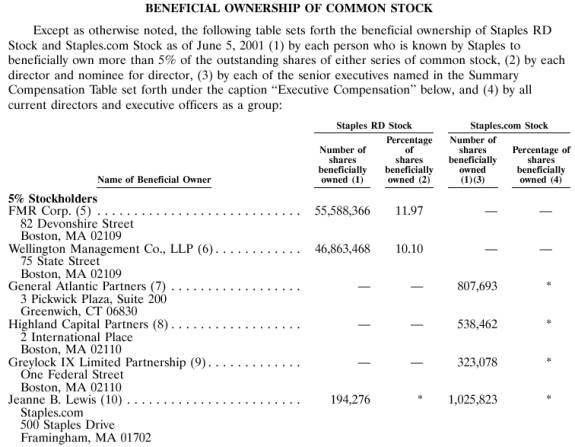
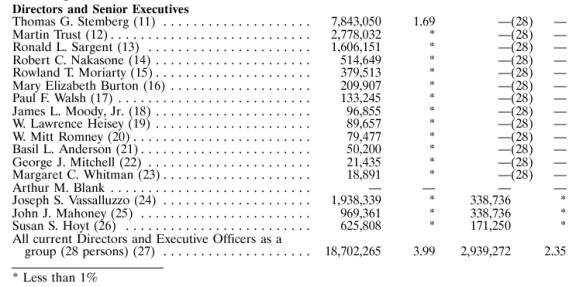
EXHIBIT
C
Directors
|
Basil Anderson |
|
|
|
Executive
Vice President and Chief Financial Officer, Campbell Soup Co.
|
|
Arthur M. Blank |
|
|
|
Retired
Co-Chairman of the Board of Directors, The Home Depot, Inc.
|
|
Mary Elizabeth Burton |
|
|
|
President
and Chief Executive Officer, BB Capital, Inc.
|
|
George J. Mitchell |
|
|
|
Former
U.S. Senator, Former Majority Leader, Special Counsel Verner, Liipfert,
Bernhard, McPherson & Hand |
|
James L. Moody, Jr. |
|
|
|
Retired
Chairman of the Board of Hannaford Bros. Co. |
|
Rowland T. Moriarty |
|
|
|
Chairman
and Chief Executive Officer, Cubex Corporation
|
|
Robert C. Nakasone |
|
|
|
Chief
Executive Officer |
|
W. Mitt Romney |
|
|
|
Managing
Director and Chief Executive Officer, Bain Capital, Inc.
|
|
Ronald L. Sargent |
|
|
|
President
and Chief Operating Officer, Staples, Inc.
|
|
Thomas G. Stemberg |
|
|
|
Chairman
of the Board and Chief Executive Officer, Staples, Inc.
|
|
Martin Trust |
|
|
|
President
and Chief Executive Officer of Mast Industries, Inc., a wholly-owned
subsidiary of The Limited, Inc. |
|
Paul F. Walsh |
|
|
|
President
and Chief Executive Officer, iDeal Partners
|
|
Margaret C. Whitman |
|
|
|
President
and Chief Executive Officer, eBay |
|
Leo Kahn |
|
|
|
Chairman
Emeritus, Co-Founder of Staples, Inc. |
|
W. Lawrence Heisey |
|
|
|
Director
Emeritus, Chairman Emeritus, Harlequin Enterprises Ltd.
|
|
David G. Lubrano |
|
|
|
Director
Emeritus, Private Investor and Business Consultant, Staples, Inc.
|
EXHIBIT
D
(Source Yahoo! Finance)
|
Top Mutual Fund Holders of SPLS |
|
Shares |
Value |
|
Fidelity Magellan Fund Inc |
4.80% |
22,300,000 |
$328,702,000 |
|
Janus Fund |
3.95% |
18,326,795 |
$270,136,958 |
|
Fidelity Equity-Income Fund |
1.65% |
7,661,538 |
$112,931,070 |
|
Fidelity Independence Fund |
|
5,100,000 |
$75,174,000 |
|
Fidelity Puritan Fund Inc |
|
4,555,700 |
$67,151,018 |
|
Vanguard Index 500 Fund |
|
4,065,023 |
$59,918,439 |
|
Investment Company Of America |
|
4,000,000 |
$58,960,000 |
|
Janus Strategic Value Fund |
|
3,512,876 |
$51,779,792 |
|
College Retirement Equities Fund-Stock Account |
|
3,162,468 |
$46,614,778 |
|
Putnam Fund For Growth And Income |
|
3,020,200 |
$44,517,748 |
EXHIBIT
E
|
||||||||||||||||||||||||||||||||||||||||||||||||||||||
|
|||||||||||||||||||||||||||||||||||||||||||||
|
|||||||||||||||||||||||||||||||||||||||||||||
|
|||||||||||||||||||||||||||||||||||||||||||||